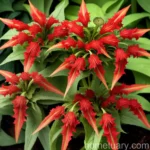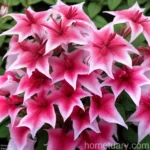Chinese Creeping Lobelia (Lobelia chinensis)
Plants are an integral part of our environment and play a crucial role in maintaining the ecological balance. They not only contribute to the aesthetic appeal of landscapes but also have significant medicinal and cultural value. One such plant that holds interest to plant enthusiasts and researchers alike is the Chinese creeping lobelia (Lobelia chinensis). In this blog post, we will dive deep into the world of Chinese creeping lobelia, exploring its culture, uses, propagation, maintenance, and much more.
What is Plant: Chinese Creeping Lobelia (Lobelia chinensis)
The Chinese creeping lobelia (Lobelia chinensis) is a herbaceous perennial known for its delicate blue or violet flowers that bloom abundantly during the summer months. It belongs to the Campanulaceae family and is native to East Asia, particularly China and Japan. This plant is characterized by its creeping or trailing growth habit, making it a popular choice for ground cover in gardens and landscapes.
Key Takeaways
Chinese Creeping Lobelia (Lobelia chinensis) Facts
- Scientific Name: Lobelia chinensis
- Family: Campanulaceae
- Native to: East Asia
- Common Names: Chinese lobelia, creeping lobelia
- Flower Color: Blue or violet
- Growth Habit: Creeping, trailing
- Uses: Ornamental, medicinal
Culture
Understanding the cultural requirements of the Chinese creeping lobelia is essential for its successful growth and development. Let’s delve into its specific cultural needs, including water, sunlight, fertilizer, soil, and pruning.
Uses
Ornamental Use
The Chinese creeping lobelia is primarily cultivated for its ornamental value. Its delicate, trailing growth and profusion of blue or violet flowers make it a popular choice for ground cover in gardens, borders, and rockeries. It adds a touch of elegance and color to the landscape, particularly when allowed to cascade over retaining walls or along slopes.
Medicinal Use
In traditional Chinese medicine, Lobelia chinensis has been used for its medicinal properties. It is believed to have anti-inflammatory and analgesic effects and has been employed in the treatment of various ailments such as respiratory disorders, rheumatism, and snakebites.
Water
Chinese creeping lobelia thrives in moderately moist soil, so it’s essential to ensure regular watering, especially during dry spells. However, it’s equally crucial to avoid waterlogging, as excessive moisture can lead to root rot and other fungal diseases.
Sunlight
For optimal growth and flowering, the Chinese creeping lobelia prefers partial shade to full sunlight. In regions with intense summer heat, providing some shade during the hottest part of the day can prevent the plant from wilting and scorching.
Fertilizer
When it comes to fertilization, Chinese creeping lobelia benefits from a balanced, water-soluble fertilizer applied every 4-6 weeks during the growing season. Avoid over-fertilizing, as this can lead to excessive foliage growth at the expense of flowering.
Soil
The Chinese creeping lobelia thrives in well-draining, humus-rich soil with a slightly acidic to neutral pH. Amending the soil with organic matter such as compost or leaf mold can improve its texture and fertility, creating an optimal growing environment for the plant.
Pruning
Pruning is essential to maintain the compact and tidy appearance of Chinese creeping lobelia. Deadheading spent flowers and light trimming of wayward stems can promote continuous blooming and prevent the plant from becoming leggy over time.
Propagation
Propagation of Chinese creeping lobelia can be achieved through various methods, including division, seeds, and cuttings. Each of these techniques offers its own unique advantages and challenges, allowing individuals to choose the most suitable approach based on their resources and expertise.
Division
Division is a straightforward method of propagation that involves splitting the plant into smaller sections, each with its own root system. This can be done in early spring or fall, allowing the divided sections to establish themselves before the onset of extreme temperatures.
Seeds
Collecting and sowing seeds is another viable option for propagating Chinese creeping lobelia. However, this method requires patience, as it may take some time for the seeds to germinate and develop into robust young plants ready for transplanting.
Cuttings
Taking stem cuttings from healthy, established plants offers a reliable way to propagate Chinese creeping lobelia. These cuttings can be rooted in a well-draining growing medium and kept under optimal environmental conditions until they develop roots and can be transplanted.
Container Popularity
The Chinese creeping lobelia’s trailing habit makes it an excellent candidate for container gardening. When planted in hanging baskets, window boxes, or large containers, it spills over the edges, creating an attractive cascade of vibrant flowers and foliage. Its adaptability to container culture allows plant enthusiasts with limited outdoor space to enjoy its beauty and charm.
Common Diseases
Despite its resilience, Chinese creeping lobelia can be susceptible to certain diseases, particularly those related to fungal infections and overmoisture. Being aware of these potential ailments and their symptoms can aid in timely intervention and effective management of the plant’s health.
Disease Diagnosis
- Root Rot:
- Symptoms: Wilting, yellowing leaves, and a foul odor emanating from the root zone.
-
Management: Improve soil drainage, reduce watering frequency, and consider using fungicidal treatments if the condition persists.
-
Powdery Mildew:
- Symptoms: White, powdery spots on leaves and stems.
-
Management: Provide adequate air circulation, avoid overhead watering, and apply fungicidal sprays if necessary.
-
Bacterial Leaf Spot:
- Symptoms: Dark, water-soaked lesions on foliage.
- Management: Remove affected plant parts, ensure good sanitation practices, and consider copper-based fungicides for severe infections.
Common Pests
While relatively resistant to pests, Chinese creeping lobelia may still encounter occasional infestations from insects that can compromise its health and appearance. Vigilance and prompt action are crucial in preventing pest populations from reaching damaging levels.
Botanist’s Tips
- Encourage natural predators and parasites such as ladybugs and lacewings to help maintain a balance of insect populations in the garden.
- Regularly inspect the plant for signs of pest activity, including chewed leaves, stippling, and abnormal growth.
Fun Facts
- The genus name “Lobelia” is in honor of the Flemish botanist Matthias de L’Obel.
- Chinese creeping lobelia is a source of nectar for hummingbirds and butterflies, making it an attractive addition to wildlife-friendly gardens.
Links to External Resources
Ensure to checkout the following links for further information on Chinese creeping lobelia (Lobelia chinensis):
1. Chinese Creeping Lobelia – Royal Horticultural Society
2. Growing Lobelia chinensis – Missouri Botanical Garden
3. Medicinal Uses of Lobelia chinensis – World Journal of Traditional Chinese Medicine
4. Lobelia chinensis: A Medicinal Plant – ResearchGate
5. Companion Plants for Chinese Creeping Lobelia – The Spruce
In conclusion, the Chinese creeping lobelia (Lobelia chinensis) is a captivating plant that offers both aesthetic and medicinal value to gardeners and plant enthusiasts. By understanding its cultural requirements, propagation methods, and potential challenges, individuals can cultivate and appreciate this beautiful species in both outdoor and container settings. Whether as a ground cover or a focal point in hanging baskets, the Chinese creeping lobelia brings a touch of elegance and charm to any garden or landscape.
References
- Missouri Botanical Garden. (n.d.). Growing Lobelia chinensis. http://www.missouribotanicalgarden.org/PlantFinder/PlantFinderDetails.aspx?kempercode=c451
- ResearchGate. (n.d.). Lobelia chinensis: A Medicinal Plant. https://www.researchgate.net/publication/283943442_Lobelia_chinensis_a_Medicinal_Plant
- Royal Horticultural Society. (n.d.). Chinese Creeping Lobelia. https://www.rhs.org.uk/plants/8583/lobelia-chinensis/details
- The Spruce. (n.d.). Companion Plants for Chinese Creeping Lobelia. https://www.thespruce.com/great-lobelia-2132300
- World Journal of Traditional Chinese Medicine. (n.d.). Medicinal Uses of Lobelia chinensis. https://www.wjotcm.com/toc/wjotcm/4/3















